Answered step by step
Verified Expert Solution
Question
1 Approved Answer
Question: 1. From the information above construct an External Factor Evaluation (EFE) Matrix for Nestle. External Issues Within the food and beverage business, Nestl competes

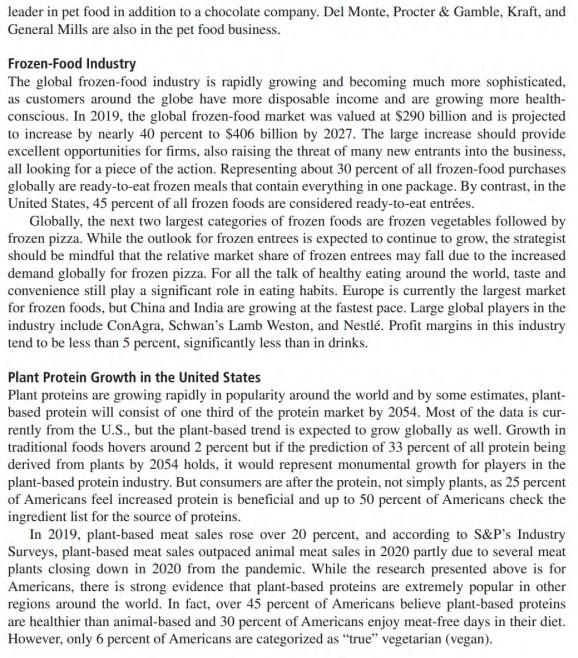
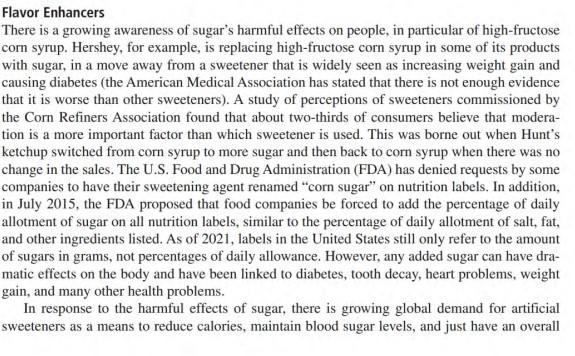
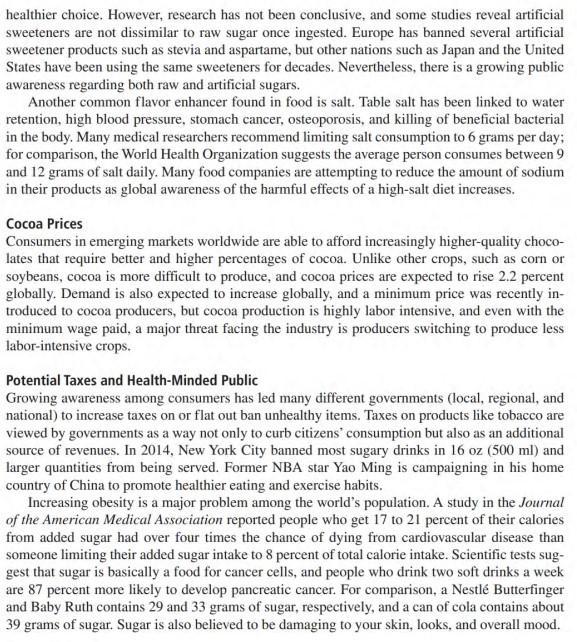
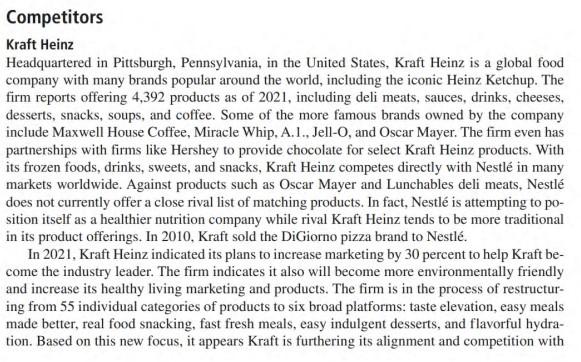
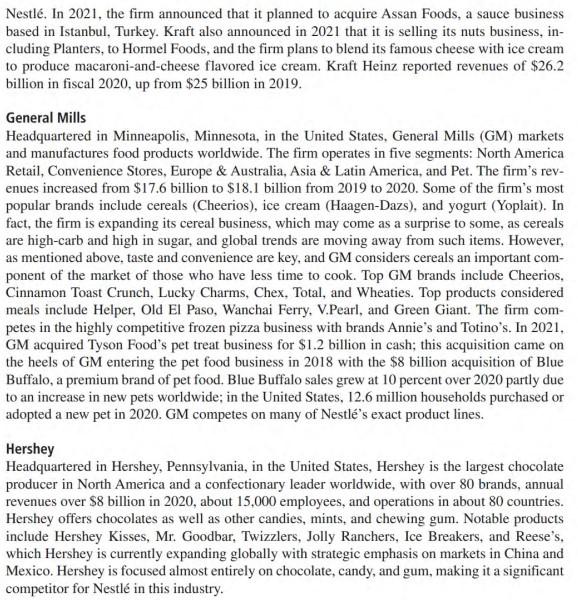
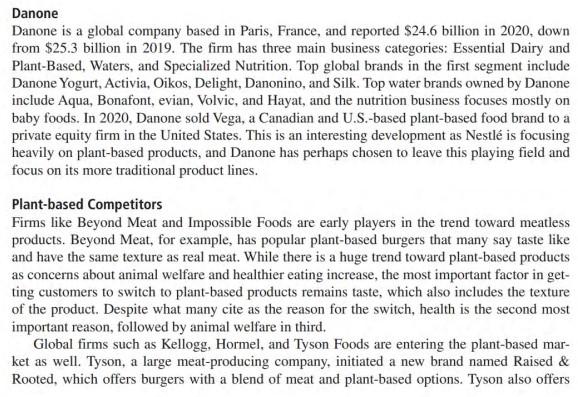
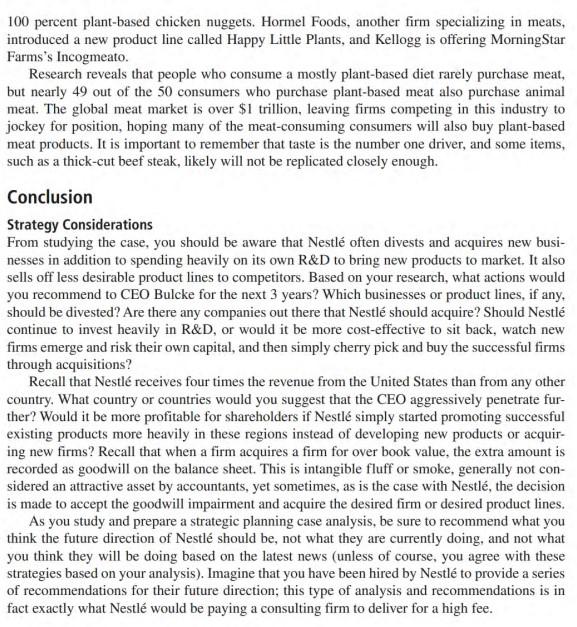
Question:
1. From the information above construct an External Factor Evaluation (EFE) Matrix for Nestle.
External Issues Within the food and beverage business, Nestl competes with global chocolate giants Hershey and Mars, French-based Danone, European-focused Nomad Foods, U.S.-based Kraft, and many more. In pet foods, Nestl competes with-perhaps surprisingly-Mars, which is the world leader in pet food in addition to a chocolate company. Del Monte, Procter \& Gamble, Kraft, and General Mills are also in the pet food business. Frozen-Food Industry The global frozen-food industry is rapidly growing and becoming much more sophisticated, as customers around the globe have more disposable income and are growing more healthconscious. In 2019, the global frozen-food market was valued at $290 billion and is projected to increase by nearly 40 percent to $406 billion by 2027 . The large increase should provide excellent opportunities for firms, also raising the threat of many new entrants into the business, all looking for a piece of the action. Representing about 30 percent of all frozen-food purchases globally are ready-to-eat frozen meals that contain everything in one package. By contrast, in the United States, 45 percent of all frozen foods are considered ready-to-eat entres. Globally, the next two largest categories of frozen foods are frozen vegetables followed by frozen pizza. While the outlook for frozen entrees is expected to continue to grow, the strategist should be mindful that the relative market share of frozen entrees may fall due to the increased demand globally for frozen pizza. For all the talk of healthy eating around the world, taste and convenience still play a significant role in eating habits. Europe is currently the largest market for frozen foods, but China and India are growing at the fastest pace. Large global players in the industry include ConAgra, Schwan's Lamb Weston, and Nestl. Profit margins in this industry tend to be less than 5 percent, significantly less than in drinks. Plant Protein Growth in the United States Plant proteins are growing rapidly in popularity around the world and by some estimates, plantbased protein will consist of one third of the protein market by 2054 . Most of the data is currently from the U.S., but the plant-based trend is expected to grow globally as well. Growth in traditional foods hovers around 2 percent but if the prediction of 33 percent of all protein being derived from plants by 2054 holds, it would represent monumental growth for players in the plant-based protein industry. But consumers are after the protein, not simply plants, as 25 percent of Americans feel increased protein is beneficial and up to 50 percent of Americans check the ingredient list for the source of proteins. In 2019, plant-based meat sales rose over 20 percent, and according to S\&P's Industry Surveys, plant-based meat sales outpaced animal meat sales in 2020 partly due to several meat plants closing down in 2020 from the pandemic. While the research presented above is for Americans, there is strong evidence that plant-based proteins are extremely popular in other regions around the world. In fact, over 45 percent of Americans believe plant-based proteins are healthier than animal-based and 30 percent of Americans enjoy meat-free days in their diet. However, only 6 percent of Americans are categorized as "true" vegetarian (vegan). Flavor Enhancers There is a growing awareness of sugar's harmful effects on people, in particular of high-fructose corn syrup. Hershey, for example, is replacing high-fructose corn syrup in some of its products with sugar, in a move away from a sweetener that is widely seen as increasing weight gain and causing diabetes (the American Medical Association has stated that there is not enough evidence that it is worse than other sweeteners). A study of perceptions of sweeteners commissioned by the Corn Refiners Association found that about two-thirds of consumers believe that moderation is a more important factor than which sweetener is used. This was borne out when Hunt's ketchup switched from corn syrup to more sugar and then back to corn syrup when there was no change in the sales. The U.S. Food and Drug Administration (FDA) has denied requests by some companies to have their sweetening agent renamed "corn sugar" on nutrition labels. In addition, in July 2015 , the FDA proposed that food companies be forced to add the percentage of daily allotment of sugar on all nutrition labels, similar to the percentage of daily allotment of salt, fat, and other ingredients listed. As of 2021 , labels in the United States still only refer to the amount of sugars in grams, not percentages of daily allowance. However, any added sugar can have dramatic effects on the body and have been linked to diabetes, tooth decay, heart problems, weight gain, and many other health problems. In response to the harmful effects of sugar, there is growing global demand for artificial sweeteners as a means to reduce calories, maintain blood sugar levels, and just have an overall healthier choice. However, research has not been conclusive, and some studies reveal artificial sweeteners are not dissimilar to raw sugar once ingested. Europe has banned several artificial sweetener products such as stevia and aspartame, but other nations such as Japan and the United States have been using the same sweeteners for decades. Nevertheless, there is a growing public awareness regarding both raw and artificial sugars. Another common flavor enhancer found in food is salt. Table salt has been linked to water retention, high blood pressure, stomach cancer, osteoporosis, and killing of beneficial bacterial in the body. Many medical researchers recommend limiting salt consumption to 6 grams per day; for comparison, the World Health Organization suggests the average person consumes between 9 and 12 grams of salt daily. Many food companies are attempting to reduce the amount of sodium in their products as global awareness of the harmful effects of a high-salt diet increases. Cocoa Prices Consumers in emerging markets worldwide are able to afford increasingly higher-quality chocolates that require better and higher percentages of cocoa. Unlike other crops, such as corn or soybeans, cocoa is more difficult to produce, and cocoa prices are expected to rise 2.2 percent globally. Demand is also expected to increase globally, and a minimum price was recently introduced to cocoa producers, but cocoa production is highly labor intensive, and even with the minimum wage paid, a major threat facing the industry is producers switching to produce less labor-intensive crops. Potential Taxes and Health-Minded Public Growing awareness among consumers has led many different governments (local, regional, and national) to increase taxes on or flat out ban unhealthy items. Taxes on products like tobacco are viewed by governments as a way not only to curb citizens' consumption but also as an additional source of revenues. In 2014, New York City banned most sugary drinks in 16oz (500 ml) and larger quantities from being served. Former NBA star Yao Ming is campaigning in his home country of China to promote healthier eating and exercise habits. Increasing obesity is a major problem among the world's population. A study in the Journal of the American Medical Association reported people who get 17 to 21 percent of their calories from added sugar had over four times the chance of dying from cardiovascular disease than someone limiting their added sugar intake to 8 percent of total calorie intake. Scientific tests suggest that sugar is basically a food for cancer cells, and people who drink two soft drinks a week are 87 percent more likely to develop pancreatic cancer. For comparison, a Nestl Butterfinger and Baby Ruth contains 29 and 33 grams of sugar, respectively, and a can of cola contains about 39 grams of sugar. Sugar is also believed to be damaging to your skin, looks, and overall mood. Kraft Heinz Headquartered in Pittsburgh, Pennsylvania, in the United States, Kraft Heinz is a global food company with many brands popular around the world, including the iconic Heinz Ketchup. The firm reports offering 4,392 products as of 2021 , including deli meats, sauces, drinks, cheeses, desserts, snacks, soups, and coffee. Some of the more famous brands owned by the company include Maxwell House Coffee, Miracle Whip, A.1., Jell-O, and Oscar Mayer. The firm even has partnerships with firms like Hershey to provide chocolate for select Kraft Heinz products. With its frozen foods, drinks, sweets, and snacks, Kraft Heinz competes directly with Nestl in many markets worldwide. Against products such as Oscar Mayer and Lunchables deli meats, Nestl does not currently offer a close rival list of matching products. In fact, Nestl is attempting to position itself as a healthier nutrition company while rival Kraft Heinz tends to be more traditional in its product offerings. In 2010 , Kraft sold the DiGiorno pizza brand to Nestl. In 2021 , Kraft Heinz indicated its plans to increase marketing by 30 percent to help Kraft become the industry leader. The firm indicates it also will become more environmentally friendly and increase its healthy living marketing and products. The firm is in the process of restructuring from 55 individual categories of products to six broad platforms: taste elevation, easy meals made better, real food snacking, fast fresh meals, easy indulgent desserts, and flavorful hydration. Based on this new focus, it appears Kraft is furthering its alignment and competition with Nestle. In 2021, the firm announced that it planned to acquire Assan Foods, a sauce business based in Istanbul, Turkey. Kraft also announced in 2021 that it is selling its nuts business, including Planters, to Hormel Foods, and the firm plans to blend its famous cheese with ice cream to produce macaroni-and-cheese flavored ice cream. Kraft Heinz reported revenues of $26.2 billion in fiscal 2020 , up from $25 billion in 2019. General Mills Headquartered in Minneapolis, Minnesota, in the United States, General Mills (GM) markets and manufactures food products worldwide. The firm operates in five segments: North America Retail, Convenience Stores, Europe \& Australia, Asia \& Latin America, and Pet. The firm's revenues increased from $17.6 billion to $18.1 billion from 2019 to 2020 . Some of the firm's most popular brands include cereals (Cheerios), ice cream (Haagen-Dazs), and yogurt (Yoplait). In fact, the firm is expanding its cereal business, which may come as a surprise to some, as cereals are high-carb and high in sugar, and global trends are moving away from such items. However, as mentioned above, taste and convenience are key, and GM considers cereals an important component of the market of those who have less time to cook. Top GM brands include Cheerios, Cinnamon Toast Crunch, Lucky Charms, Chex, Total, and Wheaties. Top products considered meals include Helper, Old El Paso, Wanchai Ferry, V.Pearl, and Green Giant. The firm competes in the highly competitive frozen pizza business with brands Annie's and Totino's. In 2021 , GM acquired Tyson Food's pet treat business for $1.2 billion in cash; this acquisition came on the heels of GM entering the pet food business in 2018 with the $8 billion acquisition of Blue Buffalo, a premium brand of pet food. Blue Buffalo sales grew at 10 percent over 2020 partly due to an increase in new pets worldwide; in the United States, 12.6 million households purchased or adopted a new pet in 2020. GM competes on many of Nestl's exact product lines. Hershey Headquartered in Hershey, Pennsylvania, in the United States, Hershey is the largest chocolate producer in North America and a confectionary leader worldwide, with over 80 brands, annual revenues over $8 billion in 2020 , about 15,000 employees, and operations in about 80 countries. Hershey offers chocolates as well as other candies, mints, and chewing gum. Notable products include Hershey Kisses, Mr. Goodbar, Twizzlers, Jolly Ranchers, Ice Breakers, and Reese's, which Hershey is currently expanding globally with strategic emphasis on markets in China and Mexico. Hershey is focused almost entirely on chocolate, candy, and gum, making it a significant competitor for Nestl in this industry. Danone Danone is a global company based in Paris, France, and reported $24.6 billion in 2020, down from $25.3 billion in 2019. The firm has three main business categories: Essential Dairy and Plant-Based, Waters, and Specialized Nutrition. Top global brands in the first segment include Danone Yogurt, Activia, Oikos, Delight, Danonino, and Silk. Top water brands owned by Danone include Aqua, Bonafont, evian, Volvic, and Hayat, and the nutrition business focuses mostly on baby foods. In 2020, Danone sold Vega, a Canadian and U.S.-based plant-based food brand to a private equity firm in the United States. This is an interesting development as Nestle is focusing heavily on plant-based products, and Danone has perhaps chosen to leave this playing field and focus on its more traditional product lines. Plant-based Competitors Firms like Beyond Meat and Impossible Foods are early players in the trend toward meatless products. Beyond Meat, for example, has popular plant-based burgers that many say taste like and have the same texture as real meat. While there is a huge trend toward plant-based products as concerns about animal welfare and healthier eating increase, the most important factor in getting customers to switch to plant-based products remains taste, which also includes the texture of the product. Despite what many cite as the reason for the switch, health is the second most important reason, followed by animal welfare in third. Global firms such as Kellogg, Hormel, and Tyson Foods are entering the plant-based market as well. Tyson, a large meat-producing company, initiated a new brand named Raised \& Rooted, which offers burgers with a blend of meat and plant-based options. Tyson also offers 100 percent plant-based chicken nuggets. Hormel Foods, another firm specializing in meats, introduced a new product line called Happy Little Plants, and Kellogg is offering MorningStar Farms's Incogmeato. Research reveals that people who consume a mostly plant-based diet rarely purchase meat, but nearly 49 out of the 50 consumers who purchase plant-based meat also purchase animal meat. The global meat market is over $1 trillion, leaving firms competing in this industry to jockey for position, hoping many of the meat-consuming consumers will also buy plant-based meat products. It is important to remember that taste is the number one driver, and some items, such as a thick-cut beef steak, likely will not be replicated closely enough. Conclusion Strategy Considerations From studying the case, you should be aware that Nestl often divests and acquires new businesses in addition to spending heavily on its own R\&D to bring new products to market. It also sells off less desirable product lines to competitors. Based on your research, what actions would you recommend to CEO Bulcke for the next 3 years? Which businesses or product lines, if any, should be divested? Are there any companies out there that Nestl should acquire? Should Nestl continue to invest heavily in R&D, or would it be more cost-effective to sit back, watch new firms emerge and risk their own capital, and then simply cherry pick and buy the successful firms through acquisitions? Recall that Nestle receives four times the revenue from the United States than from any other country. What country or countries would you suggest that the CEO aggressively penetrate further? Would it be more profitable for shareholders if Nestl simply started promoting successful existing products more heavily in these regions instead of developing new products or acquiring new firms? Recall that when a firm acquires a firm for over book value, the extra amount is recorded as goodwill on the balance sheet. This is intangible fluff or smoke, generally not considered an attractive asset by accountants, yet sometimes, as is the case with Nestl, the decision is made to accept the goodwill impairment and acquire the desired firm or desired product lines. As you study and prepare a strategic planning case analysis, be sure to recommend what you think the future direction of Nestl should be, not what they are currently doing, and not what you think they will be doing based on the latest news (unless of course, you agree with these strategies based on your analysis). Imagine that you have been hired by Nestl to provide a series of recommendations for their future direction; this type of analysis and recommendations is in fact exactly what Nestl would be paying a consulting firm to deliver for a high feeStep by Step Solution
There are 3 Steps involved in it
Step: 1

Get Instant Access to Expert-Tailored Solutions
See step-by-step solutions with expert insights and AI powered tools for academic success
Step: 2

Step: 3

Ace Your Homework with AI
Get the answers you need in no time with our AI-driven, step-by-step assistance
Get Started


